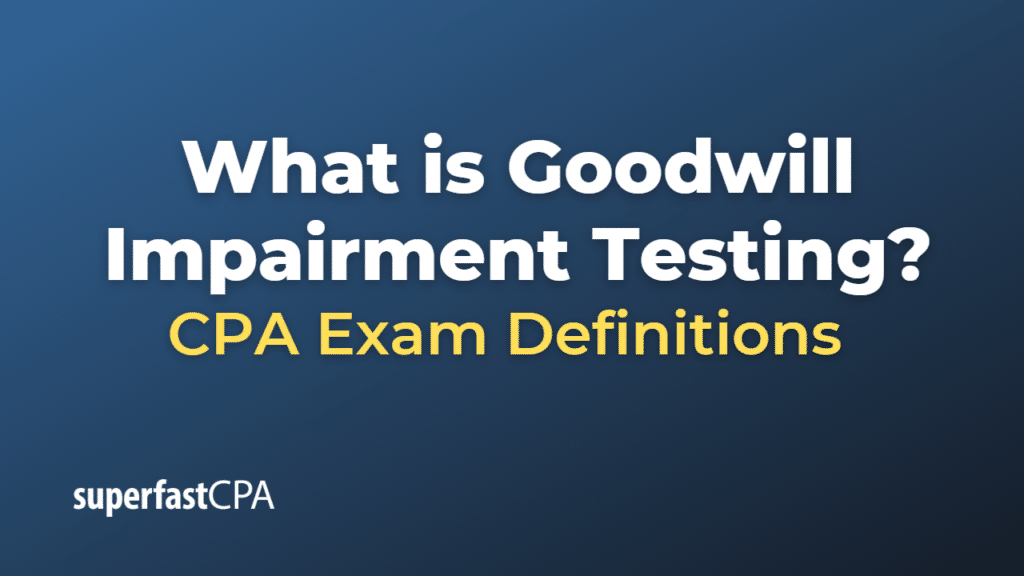Goodwill Impairment Testing
Goodwill impairment testing is a procedure that a company uses to evaluate whether the value of the goodwill it has recorded on its balance sheet remains valid or has been “impaired” (i.e., the fair value is less than its carrying amount).
Under both U.S. Generally Accepted Accounting Principles (GAAP) and International Financial Reporting Standards (IFRS), companies are required to perform this test at least annually, or more frequently if events or changes in circumstances indicate that the asset might be impaired.
The exact process can vary between GAAP and IFRS, and also due to simplifying options offered by accounting standards, but typically involves these steps:
- Identify the Cash-Generating Units (CGUs): A CGU is the smallest group of assets that generates cash flow independently. For each CGU (or group of CGUs) to which goodwill has been allocated, an impairment test is performed.
- Calculate the Carrying Value of the CGU: This is the amount at which the unit is recorded on the balance sheet, including the goodwill allocated to it.
- Estimate the Fair Value of the CGU: This involves estimating the present value of the future cash flows expected to be derived from the unit, or alternatively the market value if there’s a ready market for it. This process involves considerable judgment and may require the use of financial experts.
- Compare the Carrying Value and Fair Value: If the carrying value exceeds the fair value, it suggests that an impairment has occurred.
- Calculate and Recognize the Impairment Loss: The impairment loss is the amount by which the carrying value exceeds the fair value, but it is capped at the carrying amount of goodwill. This loss is recognized in the income statement, and the carrying value of the goodwill in the balance sheet is reduced accordingly.
This is a simplified description of a process that can be quite complex and subjective, involving significant management judgment and potentially the use of sophisticated financial models. The intention is to ensure that goodwill amounts reported on the balance sheet reflect the economic reality as closely as possible.
Example of Goodwill Impairment Testing
Let’s consider a software company, SoftCorp, which bought a cybersecurity firm, SecureNet, for $300 million a few years ago. At that time, SecureNet’s net identifiable assets were worth $200 million. SoftCorp recorded the excess $100 million as goodwill on its balance sheet.
Now, a few years later, during its annual financial review, SoftCorp performs a goodwill impairment test. The cybersecurity market has become highly competitive, and SecureNet’s profits have been declining. This is an indication that the goodwill associated with SecureNet might be impaired.
The first step is to identify the Cash Generating Unit (CGU). In this case, SecureNet itself is the CGU. The carrying value of the CGU is its recorded value on the balance sheet, which is $300 million (the purchase price).
Next, SoftCorp needs to determine the fair value of the CGU. Estimating the fair value involves forecasting the future cash flows of the CGU and discounting them to their present value, or using market data if applicable and available. After a thorough analysis, SoftCorp estimates that the current fair value of SecureNet is only $250 million.
Now comes the comparison: the carrying value of SecureNet ($300 million) is higher than its fair value ($250 million), indicating that an impairment has occurred.
Finally, SoftCorp needs to calculate the impairment loss. The impairment loss is the amount by which the carrying value exceeds the fair value. So, the goodwill impairment loss is $50 million ($300 million carrying value – $250 million fair value). However, the impairment loss cannot exceed the carrying amount of the goodwill, which in this case is $100 million, so the calculated loss is valid.
SoftCorp would then reduce the recorded value of goodwill by the impairment loss. The new carrying value of goodwill would be $50 million ($100 million original goodwill – $50 million impairment loss). SoftCorp would also record an impairment loss of $50 million in its income statement.
Remember, this is a simplified scenario. In reality, determining fair value can be a complex process that requires significant judgement and often the use of financial experts.













